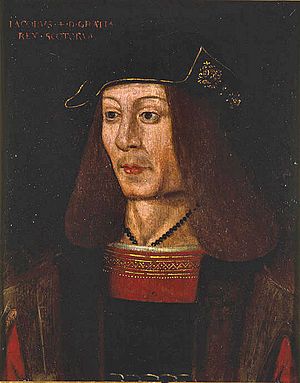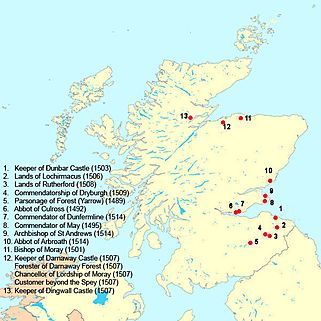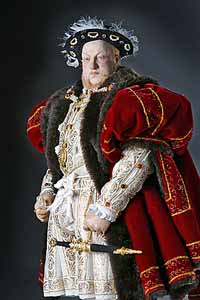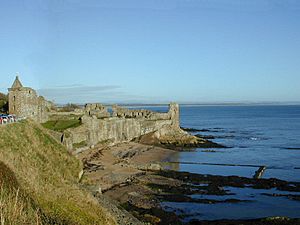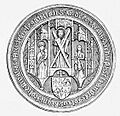Andrew Forman facts for kids
Quick facts for kids His Grace Andrew Forman |
|
|---|---|
| Archbishop of St Andrews | |
 |
|
| See | St. Andrews |
| Enthroned | 1514 |
| Reign ended | 1521 |
| Predecessor | Alexander Stewart |
| Successor | James Beaton |
| Personal details | |
| Born | c. 1465 Hutton, Berwickshire |
| Died | 11 March 1521 Dunfermline |
| Buried | St Andrews Cathedral |
| Nationality | Scottish |
| Denomination | Roman Catholic |
| Parents | Nicholas Forman and Jonet Blackadder |
| Children | Jane Forman |
| Profession | Ambassador and prelate |
Andrew Forman (around 1465 – 11 March 1521) was an important Scottish diplomat and church leader. He held many high positions in the church. These included being Bishop of Moray in 1501, Archbishop of Bourges in France in 1513, and Archbishop of St Andrews in 1514. He was also in charge of several monasteries.
Contents
Early Life and Education
Andrew Forman was likely born around 1465. His parents were Nicholas Forman and Jonet Blackadder. He had three brothers, John and Adam, who were knights. His brother Robert was a church leader in Glasgow. He also had two sisters, Isabel and another unnamed sister.
Andrew Forman went to the University of St Andrews. He finished his studies there in 1483.
A Diplomat for the King
By 1489, Andrew Forman began working for King James IV. King James wanted to bring peace to Europe. Forman's main job was to be a senior ambassador for the king. This meant he traveled a lot to places like Rome, Paris, and London. He received many gifts from the king and the Pope for his work.
In 1489, he was appointed a special church official by Pope Innocent VIII. He also received his first church income that year. In 1495, he became the Prior of May (Pittenweem), a position he kept until he died.
Forman played a key role in making peace between Scotland and England. In 1497, he and Bishop William Elphinstone helped arrange a seven-year truce with King Henry VII of England. They were also important in setting up the marriage between King James IV and Princess Margaret, King Henry's daughter. This marriage was part of the Treaty of Perpetual Peace signed in 1502.
Forman was given many church roles and lands during his career. This was common for important people in the church back then. These roles provided him with income and influence.
Church Roles and Lands
Andrew Forman held many important church positions and owned lands. Here are some of them:
- In 1489, he was given the income from Forest church.
- In 1498, he became Prior of May (Pittenweem).
- In 1501, he became Bishop of Moray.
- He was made Keeper of Dunbar Castle in 1503.
- In 1509, he became the leader of Dryburgh Abbey.
- In 1513, he was chosen as Archbishop of Bourges in France.
- In 1514, he became Archbishop of St Andrews.
- In 1516, he became the leader of Dunfermline Abbey.
He also received lands, including:
- Lochirmacus in Berwickshire in 1506.
- A lease of Mains of Dunbar in 1506/7.
- The lands of Hillhous in 1508.
- The lands of Boleskyn in 1512.
Working for Peace
When King Henry VII of England died in 1509, his son Henry VIII became king. Forman traveled to England to help renew the peace treaty between Scotland and England. This treaty was agreed upon in June 1509.
In 1510, King James sent Forman to France. He wanted Forman to convince King Louis XII to make peace with Pope Julius II. In 1511, he went to Venice to try and make peace between France and Venice.
King James was in a difficult spot. He had a peace treaty with England, but also an alliance with France. These agreements often conflicted. Forman continued his diplomatic missions to try and find a balance. However, the Pope and the French king could not agree. In July 1512, King James renewed Scotland's alliance with France.
In 1513, Pope Julius issued a warning to King James. The Pope said James would be excommunicated if he broke the treaty with England. James sent Forman to Rome to try and get the new Pope, Leo X, to change this. Forman was not successful in that mission. However, King Louis of France helped Forman become Archbishop of Bourges in July 1513.
The Battle of Flodden
On 9 September 1513, the Battle of Flodden took place in Northumberland, England. If Forman had been in Scotland, he would likely have been with the King. Many Scottish church leaders and nobles died in this battle. Among them were King James IV's son, Alexander Stewart, who was Archbishop of St Andrews.
Between 5,000 and 8,000 Scottish soldiers were killed. About 1,500 English soldiers died. Andrew Forman's brother, Sir John Forman, was captured during the battle.
After the battle, King James V, who was only 17 months old, was crowned king. His mother, Queen Margaret, became the regent (ruler) of Scotland. However, a council of lords was appointed to help rule the country. When Queen Margaret married the Earl of Angus, she had to give up her role as regent. The lords then invited John Stewart, Duke of Albany to become the new governor of Scotland.
Becoming Archbishop of St Andrews
After the Battle of Flodden, the position of Archbishop of St Andrews became empty. Both King Henry VIII of England and Pope Leo X tried to influence who would get the job. Pope Leo X first appointed his nephew, Cardinal Innocenzo Cibo, to St Andrews. However, the Scottish council stopped Cibo from entering the country.
Many people wanted the job of Archbishop of St Andrews. John Hepburn, the Prior of St Andrews, tried to take control. Gavin Douglas was also recommended for the position. He even took over the archbishop's palace, which was St Andrews Castle. But Hepburn used force to remove Douglas from the castle.
Despite the competition, Andrew Forman was very influential in Paris and Rome. With the help of the French king and Albany, he was given the position of Archbishop of St Andrews on 13 November 1514. Pope Leo X also made him a special papal representative.
There was some opposition to Forman's appointment in Scotland. However, both Douglas and Hepburn eventually gave up their claims. Albany, the governor of Scotland, eventually convinced the council to accept Forman as archbishop in February 1516.
Andrew Forman died in Dunfermline on 11 March 1521. He was buried in St Andrews Cathedral.
Forman's Reputation
Andrew Forman was highly respected by leaders across Europe. He received many rewards for his diplomatic work. King Louis XII of France made him Archbishop of Bourges. King Henry VII of England gave him a church position. King James IV gave him leadership roles in Scottish monasteries and large areas of land. The Popes also rewarded him with important church positions, including the Archbishopric of St Andrews.
Forman's relationship with Henry VIII was good at first. He helped renew the peace treaty and tried to mediate between England and France. However, as King James IV grew closer to France, Forman's trips through England became difficult. Some in England believed Forman was a main reason for the war between Scotland and England.
However, historians like MacDougall argue that Forman's reputation was unfairly damaged by rivals, such as Gavin Douglas. MacDougall points out that Forman was a key part of the peace treaty in 1502 and its renewal in 1509. He also opposed renewing the alliance with France in 1508. This suggests he was not trying to cause war.
According to the writer Robert Lindsay of Pitscottie, Forman was also known for creating amazing court shows for King James IV.
Images for kids
See Also
- Archbishop of St Andrews
- Bishop of Moray
- Battle of Flodden


